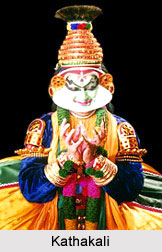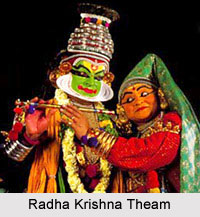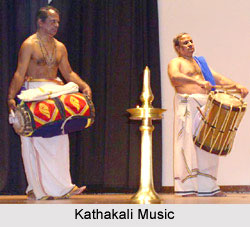 Kathakali is a combination of literature, music, painting, acting and dance. "Katha" means story and "Kali" stands for dance. This is a form of dance formerly confined only to the festival stages in temples. It symbolizes a blending of the Aryan and Dravidian cultures, for shaping its technique. The most striking element in Kathakali is the dramatic quality which is inspiring and belongs exclusively to a world of myth and legend.
Kathakali is a combination of literature, music, painting, acting and dance. "Katha" means story and "Kali" stands for dance. This is a form of dance formerly confined only to the festival stages in temples. It symbolizes a blending of the Aryan and Dravidian cultures, for shaping its technique. The most striking element in Kathakali is the dramatic quality which is inspiring and belongs exclusively to a world of myth and legend.
Origin of Kathakali
The actual roots of Kathakali can be traced to at least 1500 years earlier. The art of Kathakali incorporates the characteristic features of many of the dances and dramas of South India. It evolved out of the earlier dance forms like the Chakiayarkoothu and Koodiyattom, Mudiyettu, Theyyattom, Sastrakali, Krishnanattom and Ramanattom of Kerala. The ruler of Calicut in the 17th century wrote a poem on the life of Lord Krishna called the Krishnageeti and asked this to be performed at the temple. This was Kathakali preceded by a style called the Krishnatam, which was a masked dance drama, for very many similarities in the presentations, costumes, acting and background music could be cited in both. Another ruler of Kottarakara saw this play and was so impressed that he requested the Zamorin of Calicut to send the troupe to his kingdom, which the latter refused, angering the ruler of Kottarakara. He then decided to create his own play on the life of God Rama called the Ramanattam, which soon became popular and spread everywhere.
 The ruler Tampuran of Kottayam soon turned into Kathakali. The costumes and make up were improved so that the facial expressions were emphasized. Dramatic plots were also selected for presentation. Episodes from Mahabharata were chosen, which were more attractive to the audiences. The style was also renamed. With all these developments Kathakali remained in the shadows till the great poet Vallathol initiated Kerala Kalamandalam. Kathakali thereafter has acquired worldwide recognition.
The ruler Tampuran of Kottayam soon turned into Kathakali. The costumes and make up were improved so that the facial expressions were emphasized. Dramatic plots were also selected for presentation. Episodes from Mahabharata were chosen, which were more attractive to the audiences. The style was also renamed. With all these developments Kathakali remained in the shadows till the great poet Vallathol initiated Kerala Kalamandalam. Kathakali thereafter has acquired worldwide recognition.
Techniques of Kathakali
The technique of Kathakali includes a highly developed language of gesture, through which the artist can convey whole sentences and stories. The major original Kathakali styles included Vettathu Sampradayam, Kalladikkodan Sampradayam, and Kaplingadu Sampradayam. However these have come down to the northern and southern styles. Kathakali is a dramatic performance in which the actors interpret their emotions through highly sensitive medium. This is done by its vivid and persuasive mudras, natural and impressive gestures, graceful and rhythmic movements, pleasing choreography and above all delightful wealth of imagery. It belongs to the imaginative type spoken of in Bharata`s Natyashastra. Kathakali is a male art and the dancing is masculine.
 Theme of Kathakali
Theme of Kathakali
Kathakali draws upon the inexhaustible treasure of the ancient puranas chronicling the love and conflicts of the gods and supermen of Indian mythology for its themes. They deal with the Mahabharata, the Ramayana and the Indian Puranas. The most popular stories are Nala Charitam, Duryodhana Vadham, Kalyanasowgandhikam, Keechaka Vadham, Kiratham, Karna and Shapadham. However recently, stories from other cultures, such as the story of Mary Magdalene from the Bible, and Shakespeare`s King Lear have also been adapted into Kathakali scripts to popularise the art.
Performance in the Kathakali Dancers
In the evening one can witness a traditional Kathakali performance. It continues throughout the night, culminating at the auspicious hour of dawn, when good finally conquers evil. It has been changed for the urban audiences and is performed in a plush auditorium, within the span of a couple of hours. Earlier Kathakali used to be performed in temple premises or at the house of a local landlord.
 Costumes in Kathakali
Costumes in Kathakali
The make up of Kathakali is very intricate. Around two to three hours are required for its make up. It transforms the actor mentally and physically to portray the character Kathakali is perhaps the only dance form in India in which the masculine aspect of the dance is preserved in its elemental vigour. The makeup is very elaborate and the costumes are large and heavy.
Music in Kathakali
Several poets have contributed to a Kathakali script, which is called Kathakali Padam. Each Padam is a poem which is recited in one of the Carnatic music ragas. The stories for dance, the poetic compositions of legendary stories are performed in Carnatic style. Its local colour is strongly achieved by the use of instruments such as chenda, idakka, and shuddha maddalam. The orchestra is composed of two vocal musicians. The main one is known as ponani and the minor partner as sinkidi. Kathakali music has developed into a distinctive type of singing known as the sopana style. There is neither raga nor any elaborations like niraval and swaral singing. They sing the songs in such a manner so that the actors get full scope for abhinaya.
Dancers in Kathakali
Men usually perform in Kathakali. Men dressed in women`s costume portray female characters. A Kathakali actor needs to have immense concentration, skill and physical stamina, gained from the training based on Kalari Payette, the ancient martial art of Kerala, to prepare for the demanding role of a Kathakali actor. Around eight to ten years are required for the training of an actor before he can be considered to act. A Kathakali dancer has perfect control over the facial muscles and can express the various emotions skilfully. The body movements and footwork are very rigorous.
Today, however, Kathakali no longer enjoys the extensive patronage of Malabar aristocracy, except in a few instances. The eminent poet of Kerala, Vallathol, rescued the art from obscurity more than twenty years ago when he established the Kerala Kalamandalam in Cochin State with funds raised by a lottery. Other prominent Kathakali exponents include Padma Shri Kalamandalam Gopi, Padma Bhushan Kalamandalam Ramankutty Nair, Madavoor Vasudevan Nair, Kottakkal Sivaraman and many more.



















